
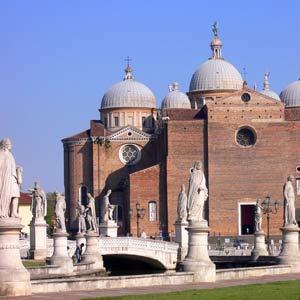 From
a large oval park Prato della Barre. The abbey of Santa Giustina.
From
a large oval park Prato della Barre. The abbey of Santa Giustina.Padua's saint patron is Sant'Antonio. He is very famous saint in Italy so many devotees come from all over Europe to worship in Padua as the Holy Land. Therefore, the most famous church in the city is Sant'Antonio church (Basilica di S. Antonio).
However, there are many other beautiful churches as well. Here some of the best churches near the city center are introduced.
They are very interesting architecturally and pictorially.
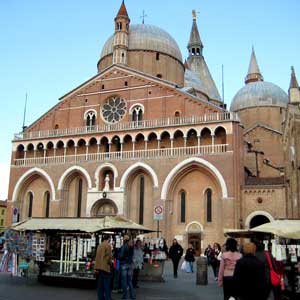 The
church of Sant'Antonio, beautiful red and white color. It has 8 big domes.
The
church of Sant'Antonio, beautiful red and white color. It has 8 big domes.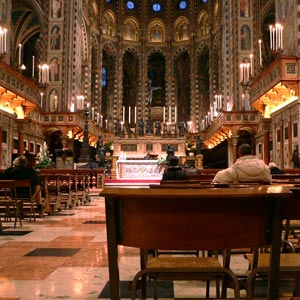 Donatello
made the bronze altar, behind the altar there is a statue of Christ crucified.
Donatello
made the bronze altar, behind the altar there is a statue of Christ crucified.![]()
This is a holy church for fervent believers. Every year many people visit this
church from all over Italy to worship. Sant'Antonio or Saint Anthony was born
in Lisbon in 1195 and buried in the suburbs of Padua in 1231.
The church was completed in 16th century. A large building with eight exterior dome drifts (cupola). Inside at the altar there are panel paintings and bronze works of Donatello, and among them you can find Saint Anthony and Angel of Music. There is a statue of the Crucifixion of Christ behind the altar. Impressive work.
The interior decoration is very luxurious. The tongue of Saint Anthony is stored and there is a miracle rock that fervent believers come to touch. Many people are praying earnestly, so please be quiet inside.
From the right side of the front entrance of the church, there is a corridor to the chapel.
There are also the chapel of Saint George and Old Church. Inside of these chapels, there are many valuable frescos so please enjoy great operas.
In front of the church there is a big statue of Gattamera by Donatello.
Opening hours: 6:20 to 18:45
Phone: 049.8789722
URL: www.basilicadelsanto.org
URL: www.santantonio.org
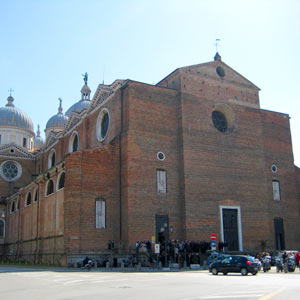 Prato
Della Valle, facing to the Abbey.
Prato
Della Valle, facing to the Abbey.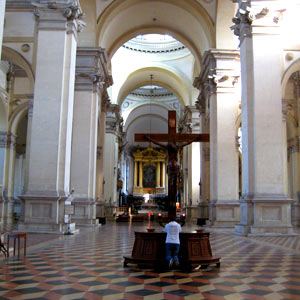 Large
space, quiet interior. Under the church you can visit the tomb of St. Giustina.
Large
space, quiet interior. Under the church you can visit the tomb of St. Giustina.![]()
St. Giustina is the "elder" patron than Saint Anthony. This large church
was completed in the 16th century at the large square Prato della Valle in the
center of the city. Being just a monastery, it's not luxury and gorgeous but
personally I prefer this church to the famous Basilica of Sant'Antonio. Compared
to the pomp of Sant'Antonio, here you can feel simple, quiet and calm atmosphere.
Located under the church there is the tomb of St. Giustina, who had died in the 6th century (still possible visit). It had been recognized as one of the most important monasteries since 15th century. In 1810, under the reign of Napoleon, the basement was closed and it was resumed in 1919.
Opening hours: 7:30 to 12:00 15:00 to 18:30 (Sunday 7:30 to 19:30)
Phone: 049.8220446
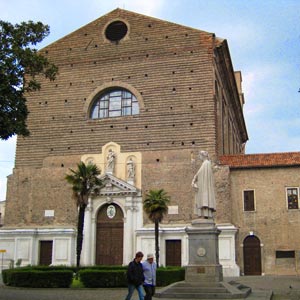 Carmine
church facade with beautiful simplicity
Carmine
church facade with beautiful simplicity![]()
It's located a little bit outside of the center, northwest of the city. The construction
by Lorenzo da Bologna had been started in 1335, and finished in 1446. It took
over 100 years! Its interior decor is showing a simple holiness. Altar is by
Antonio Canova.
It was partially collapsed in the two world wars, but it has been
repaired.
The tropical atmosphere can be seen somehow from the front facade. Indeed, the large wooden entrance door is decorated with characteristic patterns of Acanthus leaves.
Inside the Basilica (Cathedral) there are memorial monuments (memorial cards)
for those who died in the first and second World War.
The square where the church
is situated is called Piazza Petrarca and there is a statue of the poet Petrarca.
From the squares of the center (Piazza Elbe or Piazza Frutta), walk north through the Via Dante and pass the Porta (gate). You can enjoy taking a walk slowly from the old town to this street with many gates. Incidentally, I have been visiting almost every day this way. One of my favorite streets.
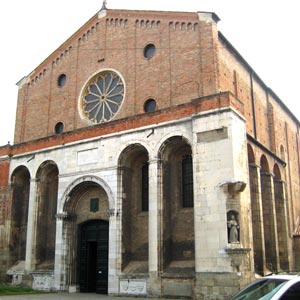 Church
of Eremitani, famous for the frescoes of Mantegna
Church
of Eremitani, famous for the frescoes of Mantegna![]()
The church was completed by Giovanni degli Eremitani in 1306. During the World
War II, after the Italian surrender, allied forces have destroyed by air attack
but then it was repaired.
There are stored many masterpieces frescoes of Mantegna.
Opening Hours: (Winter holidays) from 10.00 to 13.00 16.15 to 19.00 (winter
weekdays) 8.15 to 18.30
(Summer holidays) 10.00 to 13.00 16.30 to 19.00 (summer
weekdays) 8.15 to 18.45
Phone: 049.8756410
 Duomo
and Baptistry to the right
Duomo
and Baptistry to the right
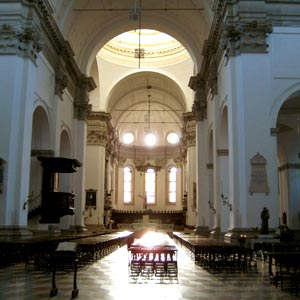 Duomo's
interior
Duomo's
interior
![]()
It's one of the three important cathedrals in Padua following the church of Sant'Antonio
and Abbey of St. Giustina. The origin of this building could ascend to the 1st
century but it's not evident. An earthquake had destroyed it in 1117. After that
it was rebuilt in Romanesque style, the successive edifice was demolished in
starting from1551 according to a design by Michelangelo: the appearance of the
medieval church can be seen in the frescoes by Giusto de' Menabuoi in the annexed
Baptistry.
Opening hours: (Weekdays) 7.30 to 12.00 15.30 to 19.30
(Holidays) from 8.00
to 13.00 15.30 to 20.45
Tel: 049.656914
Interior is covered exhaustively by fierce force frescoes from the wall to the ceiling. These frescoes are opera of Menabuoi, a painter of Giotto's school. Menabuoi was born in Florence but worked under the protection of the lords of Padua Carraresi. You can see magnificent powerful "Last Supper" and "Annunciation".
Opening hours: 10:00 to 18:00
Admission: 2.5 euros
Tel: 049.656914
It's a common path for Padua's major museums and galleries. It's also efficient for unlimited use of bus (urban and some suburbs).
Card valid location: Scrovegni Chapel (for booking 1 euro is required), City Museum, Ragione Palace, Piano Nobile and Risorgimento Museum of the upstairs of Cafe' Pedrocchi, San Michele Chapel, San Rocco Chapel, Botanic Garden, Duomo, Baptistery, Palazzo Zucchermann (discounts also at other museums).
Price: 15 euros (48 hours) 20 euros (72 hours).
Purchase Location: information points, ticket office of major attractions, bus ticket counters
TEL: 049.8767911
HP: www.padovacard.it